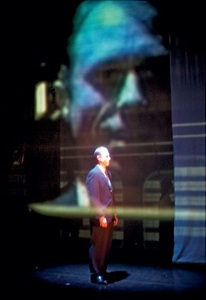There’s a
view that your memory gets worse as you get older. Maybe that’s true.
But at least part of that must be an increasing awareness of the
fallibility of memory. In other words, one feels that one’s memory is
getting worse becomes one becomes increasingly aware that it cannot be
relied upon. That’s not the same thing of course.
This evening we watched Midnight Lace,
a 1960 thriller set in London. Doris Day, a newly-married heiress
living in London with her industrialist husband (Rex Harrison), is being
plagued by increasingly threatening phone calls in a sinister voice. No
one else seems to hear them, which leads her to feel panicked and
isolated. When the killer calls on the phone to say that he is coming to
keep their appointment, the husband calls the police who suggest that
he allow himself to be seen leaving, then come back in the back door and
apprehend the killer. A man does break in and Rex returns and kills him
in a struggle. But it’s not the killer, because the killer is Rex. He
explains that he’s planned to kill her making it look that she threw
herself from the balcony when the balance of her mind was disturbed.
It’s a pretty decent thriller, a period
piece but pretty effective. The thing that struck me, though, was that I
saw it when I was 12 or so. I vividly remember the moment when Doris
Day is alone and terrified in the dark; there are billowing curtains;
she is sure the killer is coming to do his worst; a figure is seen in
the French window... and it’s her husband. With relief she grasps him,
sobbing into his shoulder. But he begins to speak, and is doing so in
the thin, metallic voice on the phone, thus revealing it’s him. It’s a
brilliant moment, misdirection, reversal, shock, imminent threat, the
perfect twist.
Except it doesn’t happen like that. We
see the two men struggle. A shot rings out. We don’t know who is hit. We
see a tape recorder on the floor and a man stands and picks it up; he
presses play and that eerie voice echoes in the room. Doris Day sees
that it’s her husband and is overjoyed. She embraces him and then runs
to the phone to call the police (surely they should be here by now?).
Rex Harrison puts his finger down on the buttons, cutting her off, and
so begins his explanation.
What’s weird is that my version is better. It’s
certainly a more economical twist, done through a moment of horror and, to be Aristotelian for a moment, anagnorisis and peripateia, rather than through the rather leaden
exposition. (Seriously, if you were going to kill your wife, would you
talk her through the plan?)
I’m reminded that one of my principles
of adapting a novel is to not read it. That is, leave a long gap and
then try to remember the plot; the memory rather neatly patches up plot
holes, cuts off dangling and extraneous loose ends, and delivers you
back a much sleeker version of the original. In this instance, what’s
doubly weird is that I always remember remembering my version of the
ending. I don’t have any sense that my memory has shifted. I have a
strong visual memory of that moment. Doris Day’s back to us, Rex
Harrison’s face over her shoulder, the French windows behind, the
billowing net curtains, and him starting to speak, sinister as you like,
in her ear.
Another curious version of this happened with Casting the Runes.
This was a 1979 TV adaptation of the M R James short story. One scene
that has always stayed with me is the moment when the wizard Mr Karswell
conjures a monstrously huge spider to appear in his enemy’s bed. I
remember the scene vividly. Pillow at the right of the screen, blanket,
foot of the bed to the left, and the man getting into bed and the scream
of horror and the ghastly thing’s legs jabbing out the side. I was so
terrified, I took a torch to bed and checked in it to ensure there were
no spiders. Any stray feeling at my feet made me jump with fear.
When a DVD of the programme was released a couple of years ago, I bought it. Mainly for nostalgic reasons.
The scene was exactly as I remembered it
but the bed was the other way around. The pillow at the left, the foot
at the right of the screen. It was my bed that
had the pillow on the right and the foot on the left. Somehow, in that
vivid memory, I had taken the features of the TV image and reversed them
to fit into the image of my own bed. Of course, that’s the process I
was going through on that sleepless night of 24 April 1979.
I’ve also noted in some academic writing about mental imagery, the way that we can - dreamlike - transpose, condense and fuse multiple real images in our mental images. Just as it’s understandable and normal to be able to say ‘In my dream I was in Rome but it was also the Moon’, in our remembered visual images - because in these two examples it’s intensely remembered visual images we’re discussing - I can fuse two entirely separate images. I’m not sure what other image I’m fusing with Midnight Lace but it’s still strange to me that 3 hours ago I sat down the watch the film, confidently anticipating seeing again that vivid memory from my childhood and being oddly disappointed that my memory was a better dramaturg than the film’s screenwriters.



![photo[1].jpg](https://images.squarespace-cdn.com/content/v1/513c543ce4b0abff73bc0a82/1362919072201-PZO854G4SEB794DVOEI8/photo%5B1%5D.jpg)
